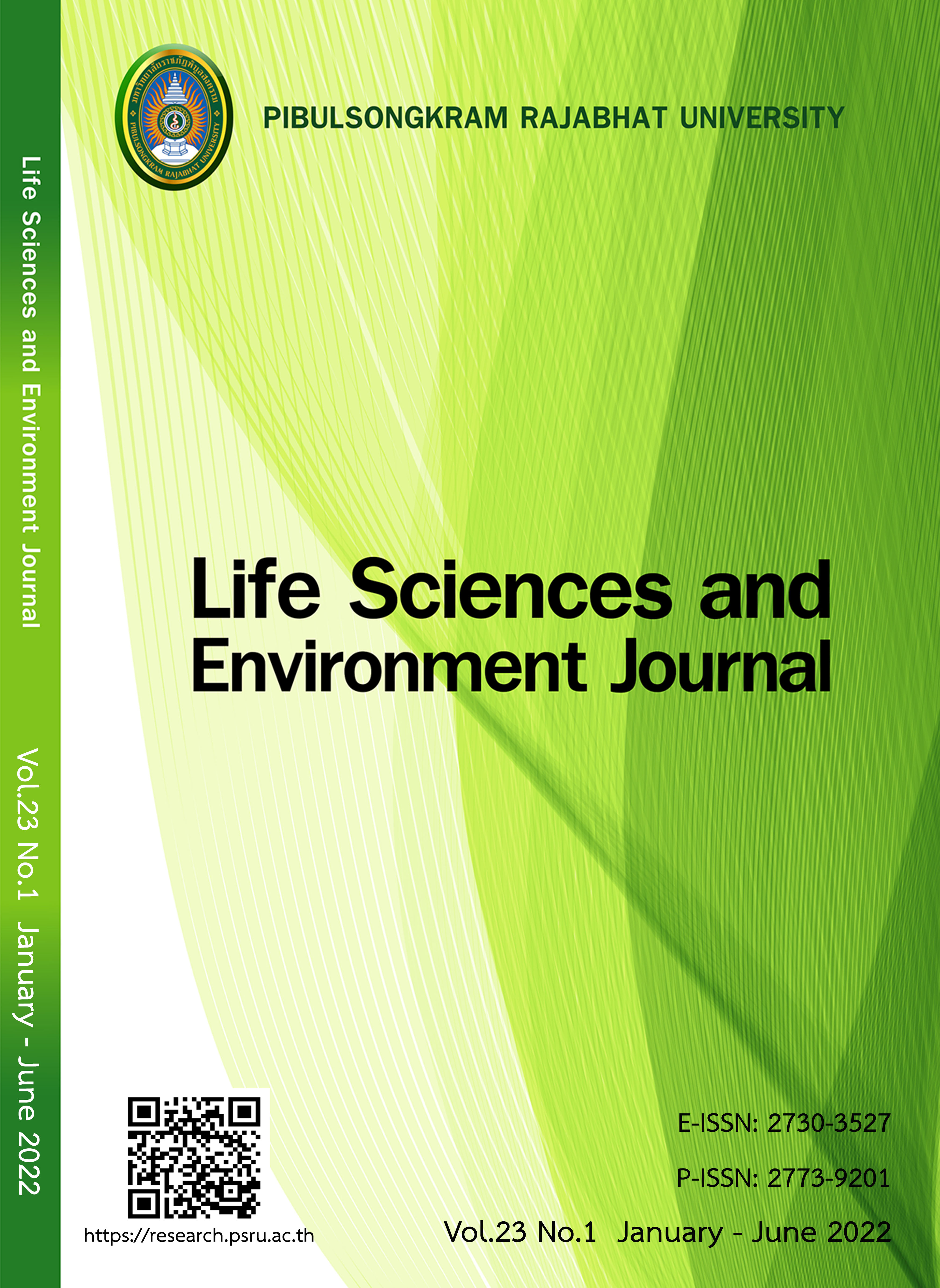ENVIRONMENT IMPACT AND CARBON FOOTPRINT ASSESSMENT OF OIL PRODUCTION FROM PLASTIC WASTE: A CASE STUDY OF SMALL-SCALE FACTORY
DOI:
https://doi.org/10.14456/lsej.2022.6Keywords:
Plastic waste, Pyrolysis, Life cycle assessment, Carbon footprintAbstract
This research presents the results of the environmental impact assessment and carbon footprint of oil production from plastic waste in Thailand, utilizing the ISO 14040 series guidelines and Life Cycle Assessment (LCA) ReCiPe 2016 Midpoint method. The assessment takes into account the activities of raw material acquisition, transportation and production processes in the factory (Candle to Gate), including the amount of waste and air emissions. The study showed 18 indicators of midpoint impact. Combustion of fuel to generate heat energy in the production process is considered a significant factor in the impact on environment. It was found that 1 cycle of oil production (3,000 kg) has a global warming of 13,200 kg carbon dioxide equivalent (kgCO2-eq), fine particulate matter formation of 13.4 kg equivalent (kgPM2.5-eq) and water consumption 29.7 m3, associated with the endpoint impact on 3 indicators: human health impact (0.177 daily), ecosystem damage impact (0.000332 species.year) and resource depletion impact (0.593 USD2013). For the Carbon Footprint assessment, there was an overall total value of 528 tonnes of carbon dioxide equivalent per year (tonCO2-eq /year) based on oil production at 40 cycles/year. The results of this research can be used as a basis for improving the production process and considering an alternative fuel. It is also used as a policy guide for decision-making on environmentally-friendly activities. This will contribute to the sustainable development of energy and the environment of Thailand.
References
Clemons SKC, Salloum CR, Herdegen KG, Kamens RM, Gheewala SH. Life cycle assessment of a floating photovoltaic system and feasibility for application in Thailand. Renewable Energy Journal 2021;168:448-462.
Delft C. Exploration chemical recycling-extended summary what is the potential contribution of chemical recycling to dutch climate policy; 2020.
Ekabut T, Reubroycharoen P, Uttamaprakrom W. A study of fuel production potential from plastic waste in Thailand. Journal of Energy Research 2014;11(1):38-49.
EPA. Compilation of Air Pollutant Emissions Factors (AP-42). United states environmental protection agency. 2003. Available at: https://www3.epa.gov/ttn/chief/ap42/ch01/final/c01s06.pdf. Accessed: August 2, 2021.
EPPO. Guidelines for promoting oil petroleum from plastic waste Energy Policy and Planning office (EPPO) Ministry of Energy. 2019. Available at: http://www.eppo.go.th/images/petroleum/Biofuels/
oilplasticwaste.pdf. Accessed: August 2, 2021.
Fukushima M, Shioya M, Wakai K, Ibe H. Toward maximizing the recycling rate in a Sapporo waste plastics liquefaction plant. Journal of Material Cycles and Waste Management 2009;11(1):11-18.
Gallo F, Fossi C, Weber R, Santillo D, Sousa J, Ingram I, Nadal A. et al. Marine litter plastics and microplastics and their toxic chemicals components: the need for urgent preventive measures. Environmental Sciences Europe 2018;30(1):13.
Gear M, Sadhukhan J, Thorpe R, Clift R, Seville J, Keast M. A life cycle assessment data analysis toolkit for the design of novel processes – a case study for a thermal cracking process for mixed plastic waste. Journal of Cleaner Production 2018;180:735-747.
Geyer R, Jambeck JR, Law KL. Production, use, and fate of all plastics ever made. Science Advances 2017;3(7):e1700782.
GreenDelta. OpenLCA. 2021. Available at: https://www.openlca.org. Accessed July 5, 2021.
Huijbregts MAJ, Steinmann Z, Elshout PMF, Stam G, Verones F, Vieira MDM, Hollander A. et al. ReCipe 2016: A harmonized life cycle impact assessment method at midpoint and endpoint level report I: Characterization. 2016. Available at: http://hdl.handle.net/10029/620793. Accessed July 12, 2021.
IPCC. Climate change 2013 the physical science basis. 2013. Available at: http://www.
climatechange2013.org/images/report/WG1AR5_ALL_FINAL.pdf. Accessed July 5, 2021.
ISO. ISO 14044 - Environmental management- life cycle assessment - Requirements and guidelines. Geneva; 2006.
Jeswani H, Kruger C, Russ M, Horlacher M, Antony F, Hann S, Azapagic A. Life cycle environmental impacts of chemical recycling via pyrolysis of mixed plastic waste in comparison with mechanical recycling and energy recovery. Science of The Total Environment 2021;769:144483.
Khoo HH. LCA of plastic waste recovery into recycled materials, energy and fuels in Singapore. Resour Conserv Recycl 2019;145(6):67-77.
Prasara-A J, Gheewala SH. Applying Social Life Cycle Assessment in the Thai Sugar Industry: Challenges from the field. Journal of Cleaner Production 2018;172(5):335-346.
PCD. Thailand State of pollution report 2019. Pollution control department. 2019. Available at: https://www.pcd.go.th/wp-content/uploads/2020/09/pcdnew-2020-09-03_08-10-17_397681.pdf. Accessed July 14, 2021.
PlasticsEurope. PlasticsEurope Plastics – the facts 2019. 2019. Available at: https://www.plasticseurope. org/application/files/9715/7129/9584/FINAL_web_version_Plastics_the_facts2019_14102019.pdf. Accessed August 9, 2021.
Rewlay-ngoen C, Papong S. Environmental impact assessment of a rotary compressor in Thailand based on life cycle assessment methodology. SN Applied Sciences 2020;2(9):1526.
Silva DAL, Nunes AO, Piekarski CM, Moris ADS, Souza VLSMD, Rodrigues TO. Why using different Life Cycle Assessment software tools can generate different results for the same product system? A cause–effect analysis of the problem. Sustainable Production and Consumption 2019;20:304-315.
Somoza-Tornos A, Gonzalez-Garay A, Pozo C, Graells M, Espuna A, Guillen-Gosalbez G. Realizing the potential high benefits of circular economy in the chemical industry: Ethylene monomer recovery via polyethylene pyrolysis ACS sustain. Chemical Engineering Journal 2020;8(9):3561-3572.
WHO. WHO methods and data sources for global burden of disease estimates 2000-2011. world health organization. 2013. Available at: https://www.who.int/healthinfo/statistics/GlobalDALY methods_2000_ 2011.pdf. Accessed August 16, 2021.
Downloads
Published
How to Cite
Issue
Section
License
Copyright (c) 2022 Life Sciences and Environment Journal

This work is licensed under a Creative Commons Attribution-NonCommercial-NoDerivatives 4.0 International License.
Each article is copyrighted © by its author(s) and is published under license from the author(s).










